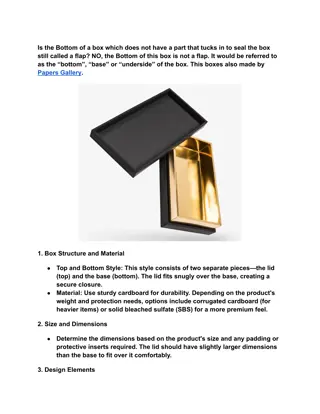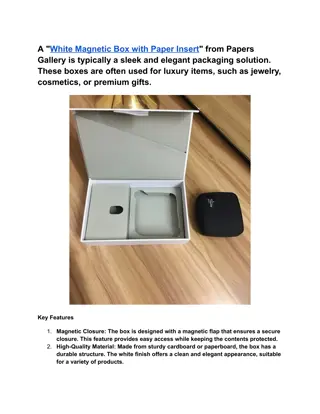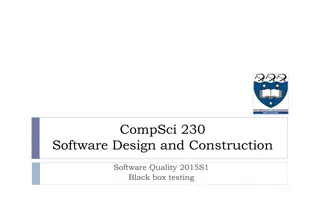Types of Testing and White-box Testing Summary
This content covers various types of testing, including white-box testing methods such as statement coverage, path coverage, branch testing, condition coverage, and Cyclomatic complexity. It explains how to test a system by inputting test data, observing outputs, checking for expected behaviors, noting failures, and debugging. It also distinguishes between errors and failures, emphasizing the importance of understanding defects in software testing processes. The role of white-box testing, including designing test cases and conducting static testing, is highlighted. Desk checking, an essential step in static white-box testing done by programmers before code execution, is also discussed.
Download Presentation

Please find below an Image/Link to download the presentation.
The content on the website is provided AS IS for your information and personal use only. It may not be sold, licensed, or shared on other websites without obtaining consent from the author.If you encounter any issues during the download, it is possible that the publisher has removed the file from their server.
You are allowed to download the files provided on this website for personal or commercial use, subject to the condition that they are used lawfully. All files are the property of their respective owners.
The content on the website is provided AS IS for your information and personal use only. It may not be sold, licensed, or shared on other websites without obtaining consent from the author.
E N D
Presentation Transcript
Streamlining Funding Safety
Support the elimination of federal oversight requirement for projects of $5 million or less consistent with Section 1317 as established in MAP- 21.
Small, Low Risk Projects Less than $5M Within the ROW What Title 23 requirements are most painful?
Long Term Bill Separate Funding Pool for Structurally Deficient Bridges Maintain Off-System Set-Aside for Bridges
Designate a separate funding pool for all structurally deficient or functional obsolete bridges, regardless of ownership, with the goal of funding the rehabilitation or replacement 50% of these structures within the period of reauthorization.
Require States to coordinate with Locals on SHSPs Allocate funding based on fatalities and serious injuries Establish TZD Grants
NACE 2015 April























